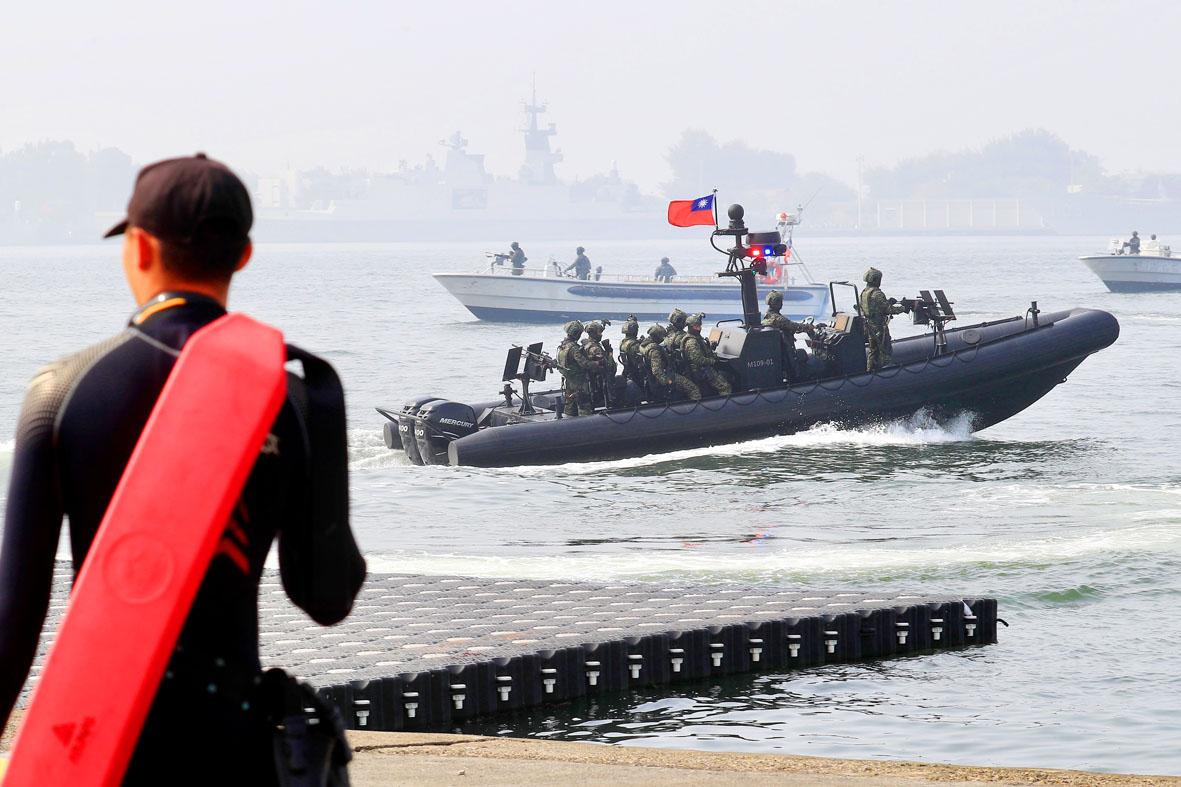Military experts yesterday urged the Ministry of National Defense to increase defense spending to at least NT$400 billion (US$14.15 billion).
The academics made the suggestions after China on Friday unveiled its national defense budget of 1.35 trillion yuan (US$208 billion), which is 16 times larger than Taiwan’s defense budget of NT$361.7 billion.
Su Tzu-yun (蘇紫雲), director of the Institute of National Defense and Strategic Research’s division of defense strategy and resources, said the year-on-year increase of Chinese defense spending was political and defense-related.

Photo: EPA-EFE
The year 2027 would mark the centennial of the founding of the Chinese People’s Liberation Army (PLA), which it plans to celebrate by launching its third carrier, and continuing production of Type 075 amphibious assault ships, Type 096 ballistic missile submarines and H-20 stealth bombers, Su said.
The new units would allow China to stabilize its influence within the first island chain and further project its power into the second island chain, satisfying Beijing’s military and political goals, he said.
The increased production of military hardware would also be in line with Chinese President Xi Jinping’s (習近平) promotion of a “dual circulation” strategy, as it would stimulate the economy, bolster the military and achieve political stability, Su said.
Su also said the ministry should scale its defense spending to at least NT$400 billion to balance the military’s upkeep costs and investment in precision munition and platforms.
National Taiwan University associate professor of political science Chen Shih-min (陳世民) said that the disparity in defense spending across the Taiwan Strait has been extant for many years, adding that the Chinese military’s near-daily incursions into Taiwan’s air defense identification zone over the past half year is clearly hostile and threatening.
Despite this, Taiwan’s national defense has failed to comprise 3 percent of its GDP, while Israel, which faces military threats that are no less severe than Taiwan’s, has maintained defense spending equal to 5 percent of its GDP, he said.
Chen said that he was not arguing for a military arms race with China, but current defense spending would be hard-pressed to keep up with the cost of arms sales packages announced under former US president Donald Trump and President Tsai Ing-wen’s (蔡英文) adoption of an indigenous arms manufacturing program.
Sheu Jyh-shyang (許智翔), a postdoctoral fellow at the Institute for National Defense and Security Research, said that the disparate funding available to Taiwan and Chinese militaries lends more credence to support asymmetric warfare.
Sheu cited the use of large quantities of precision munitions to target platforms developed by China, as an example of goals for Taiwan to focus on.

TRAGEDY STRIKES TAIPEI: The suspect died after falling off a building after he threw smoke grenades into Taipei Main Station and went on a killing spree in Zhongshan A 27-year-old suspect allegedly threw smoke grenades in Taipei Main Station and then proceeded to Zhongshan MRT Station in a random killing spree that resulted in the death of the suspect and two other civilians, and seven injured, including one in critical condition, as of press time last night. The suspect, identified as a man surnamed Chang Wen (張文), allegedly began the attack at Taipei Main Station, the Taipei Fire Department said, adding that it received a report at 5:24pm that smoke grenades had been thrown in the station. One man in his 50s was rushed to hospital after a cardiac arrest

SAFETY FIRST: Double the number of police were deployed at the Taipei Marathon, while other cities released plans to bolster public event safety Authorities across Taiwan have stepped up security measures ahead of Christmas and New Year events, following a knife and smoke bomb attack in Taipei on Friday that left four people dead and 11 injured. In a bid to prevent potential copycat incidents, police deployments have been expanded for large gatherings, transport hubs, and other crowded public spaces, according to official statements from police and city authorities. Taipei Mayor Chiang Wan-an (蔣萬安) said the city has “comprehensively raised security readiness” in crowded areas, increased police deployments with armed officers, and intensified patrols during weekends and nighttime hours. For large-scale events, security checkpoints and explosives

A car bomb killed a senior Russian general in southern Moscow yesterday morning, the latest high-profile army figure to be blown up in a blast that came just hours after Russian and Ukrainian delegates held separate talks in Miami on a plan to end the war. Kyiv has not commented on the incident, but Russian investigators said they were probing whether the blast was “linked” to “Ukrainian special forces.” The attack was similar to other assassinations of generals and pro-war figures that have either been claimed, or are widely believed to have been orchestrated, by Ukraine. Russian Lieutenant General Fanil Sarvarov, 56, head

PUBLIC SAFETY: The premier said that security would be tightened in transport hubs, while President Lai commended the public for their bravery The government is to deploy more police, including rapid response units, in crowded public areas to ensure a swift response to any threats, President William Lai (賴清德) said yesterday after a knife attack killed three people and injured 11 in Taipei the previous day. Lai made the remarks following a briefing by the National Police Agency on the progress of the investigation, saying that the attack underscored the importance of cooperation in public security between the central and local governments. The attack unfolded in the early evening on Friday around Taipei Main Station’s M7 exit and later near the Taipei MRT’s Zhongshan